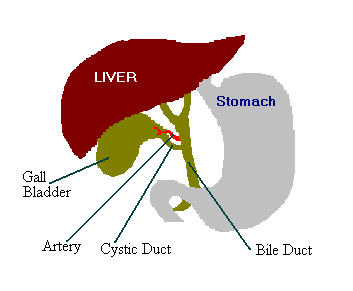
Slipped stones, jaundice and pancreatitis (pan - kree - at - eye - tis) are the result of stones in the gall bladder. To understand what they mean, one needs to know just a bit about what a gall bladder is and what it is attached to within the body.

The picture on the left is a representation of the gall bladder and the organs surrounding it. The liver produces bile which flows down to the intestine in a tube called the "Bile duct". The gall bladder is a bag-like organ which is like a branch on the right side of the bile duct.
The bile duct must always remain open and unblocked so that bile from the liver can flow into the intestine, and if the bile duct gets blocked, jaundice will occur. So, if a stone slips out of the gall bladder and passes through into the bile duct, it may block the duct. If this occurs, the urine will turn deep yellow-red as the first sign of jaundice, followed by a yellow discoloration of the eyes and skin. This is the usual way in which jaundice occurs in the presence of gall bladder stones, but please remember that there are other causes of jaundice as well.
Incidentally, just before the bile duct enters the intestine, it is usually joined by another narrow pipe carrying digestive juices from the pancreas. (not shown in the picture) Sometimes, a gallstone in the bile duct can block this digestive juice pipe from the pancreas ("pancreatic duct") and this can lead to "pancreatitis". In pancreatitis, the digestive juices from the pancreas begin to digest the pancreas itself, leading to a fairly serious condition.
TREATMENT: Occasionally, slipped stones causing jaundice or pancreatitis may pass out into the intestine on their own, and are eliminated in the stool. But often, they need to be removed, and this is usually done in one of two ways.
One method used nowadays is called an ERCP, in which an endoscope is passed from the mouth and the stomach down to the opening of the bile duct in the intestine and the opening is enlarged, after which wire-like instruments can be used to extract the stones in the bile duct. After this, the gall bladder will have to be removed (nowadays by keyhole surgery) at a separate sitting.
The other method is the age-old technique of open operation in which the bile duct is cut open at an operation and the stones removed, after which the gall bladder and its contained stones are removed at the same sitting.
 HOME
HOME  EMAIL ME
EMAIL ME 